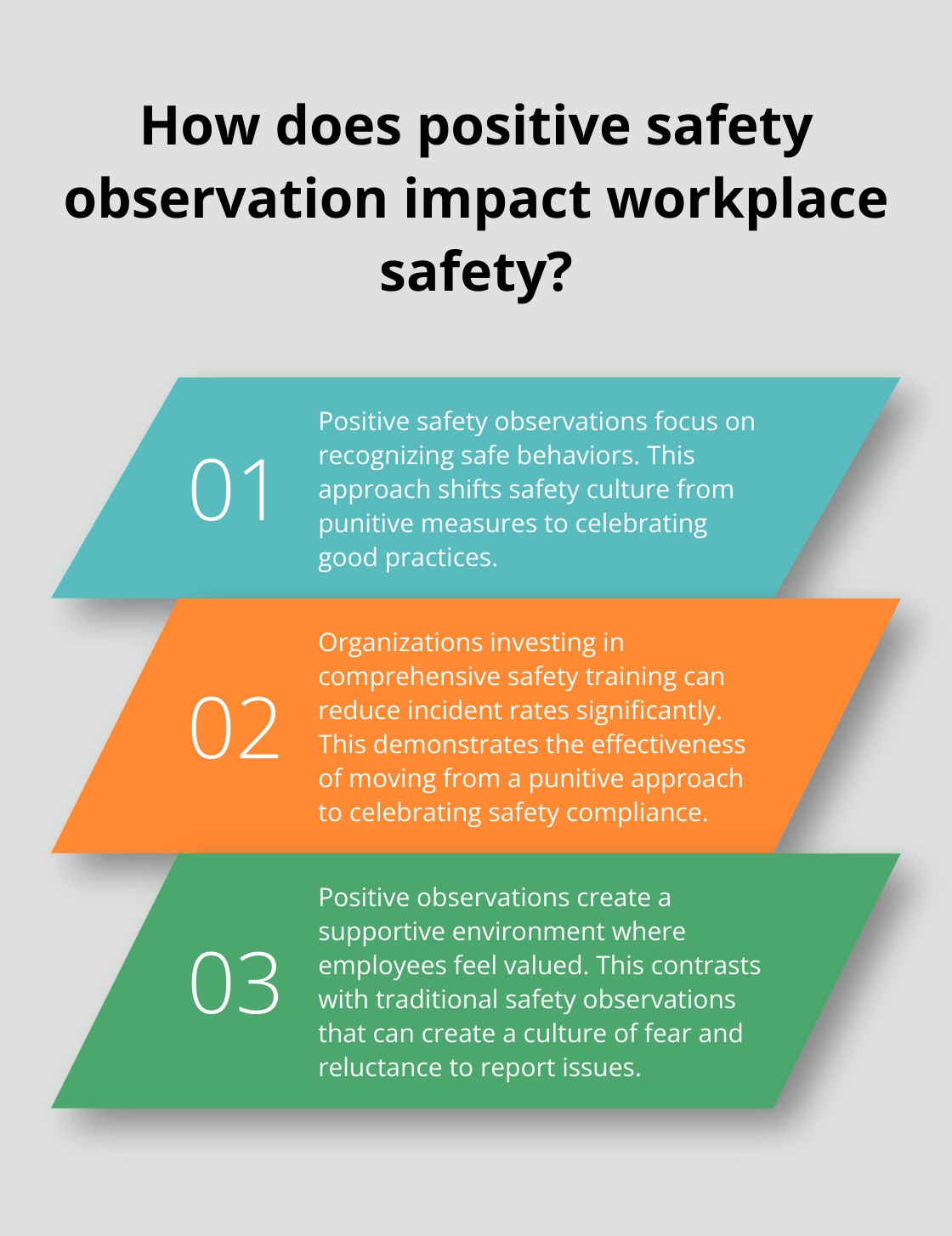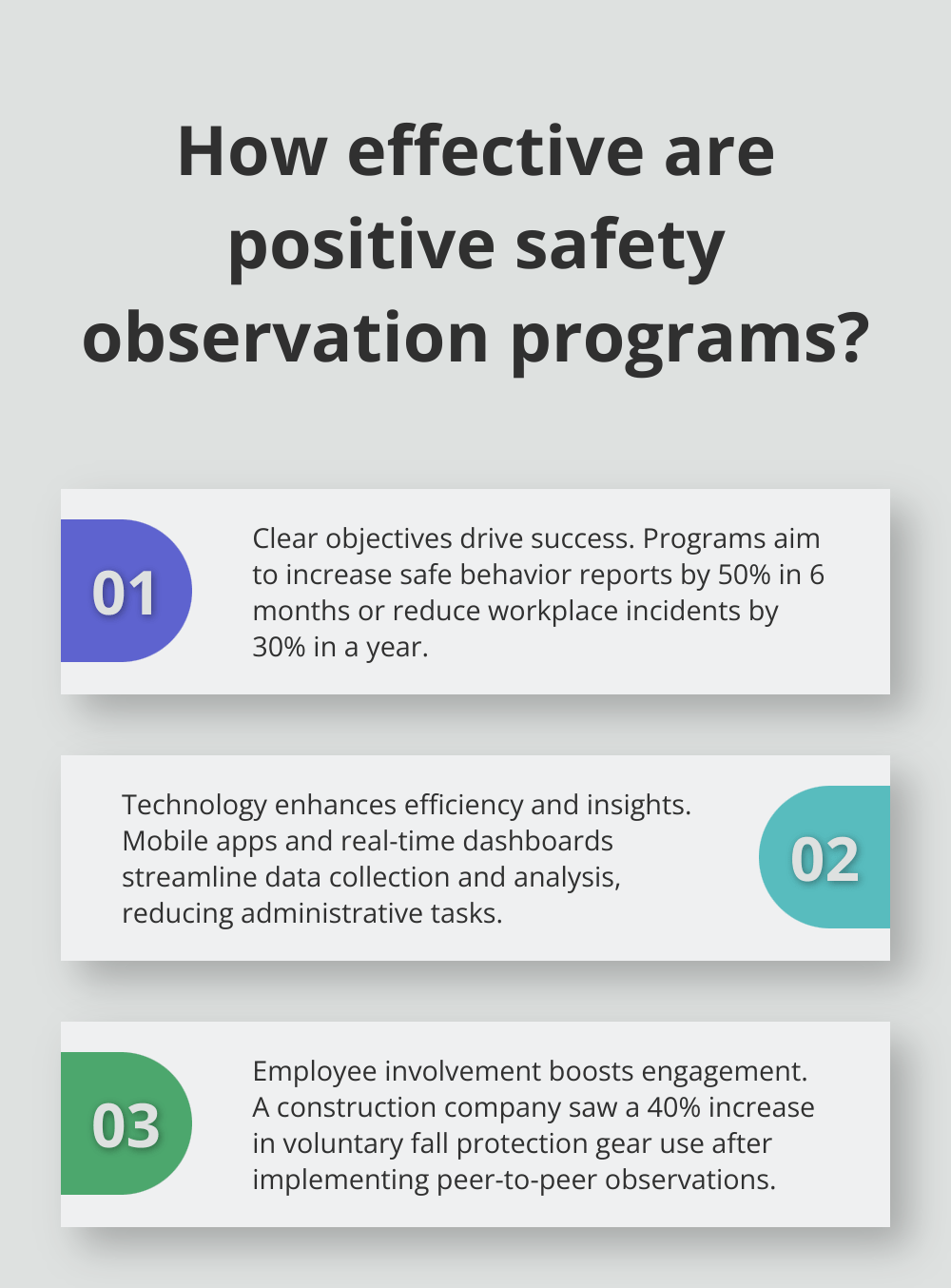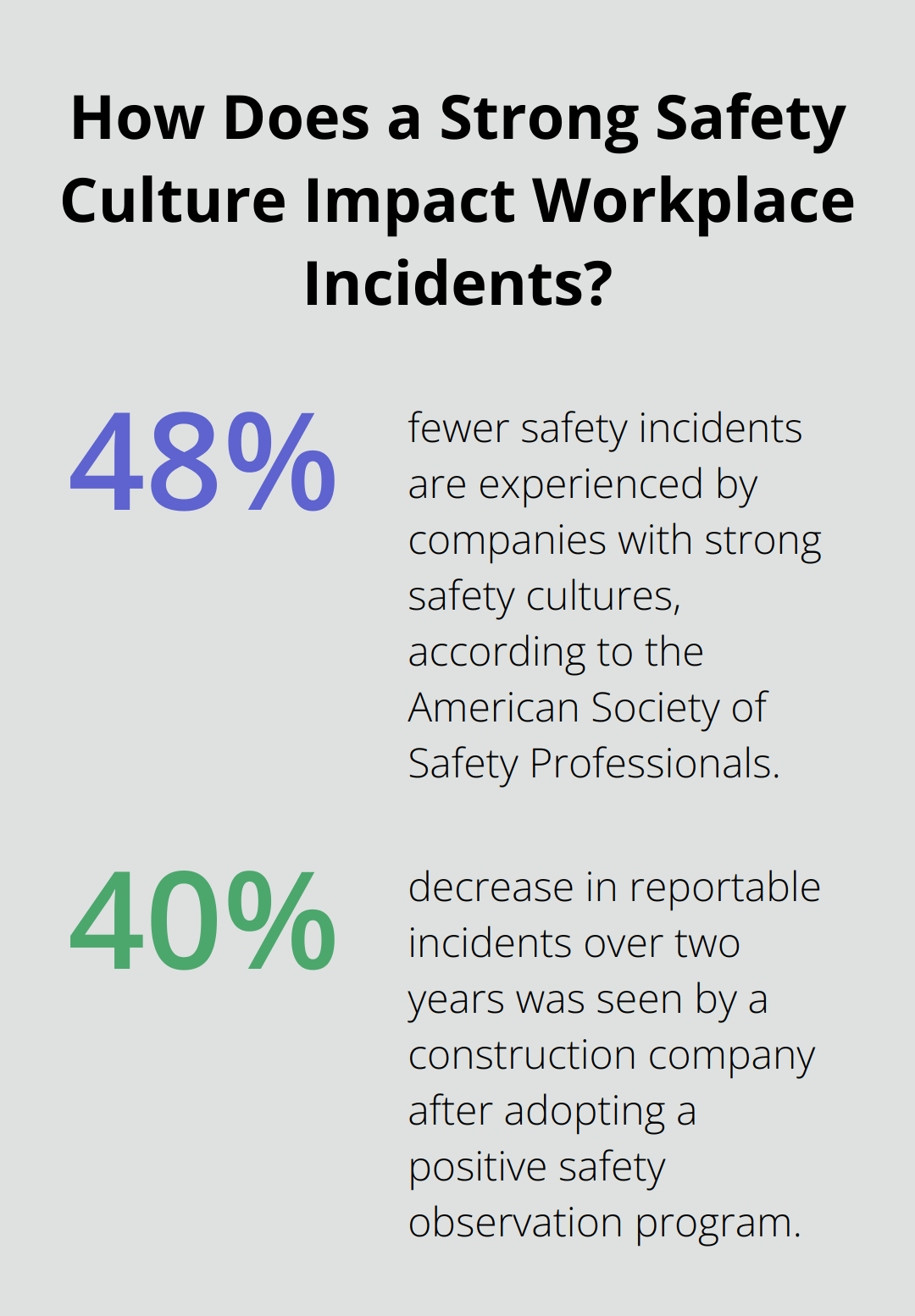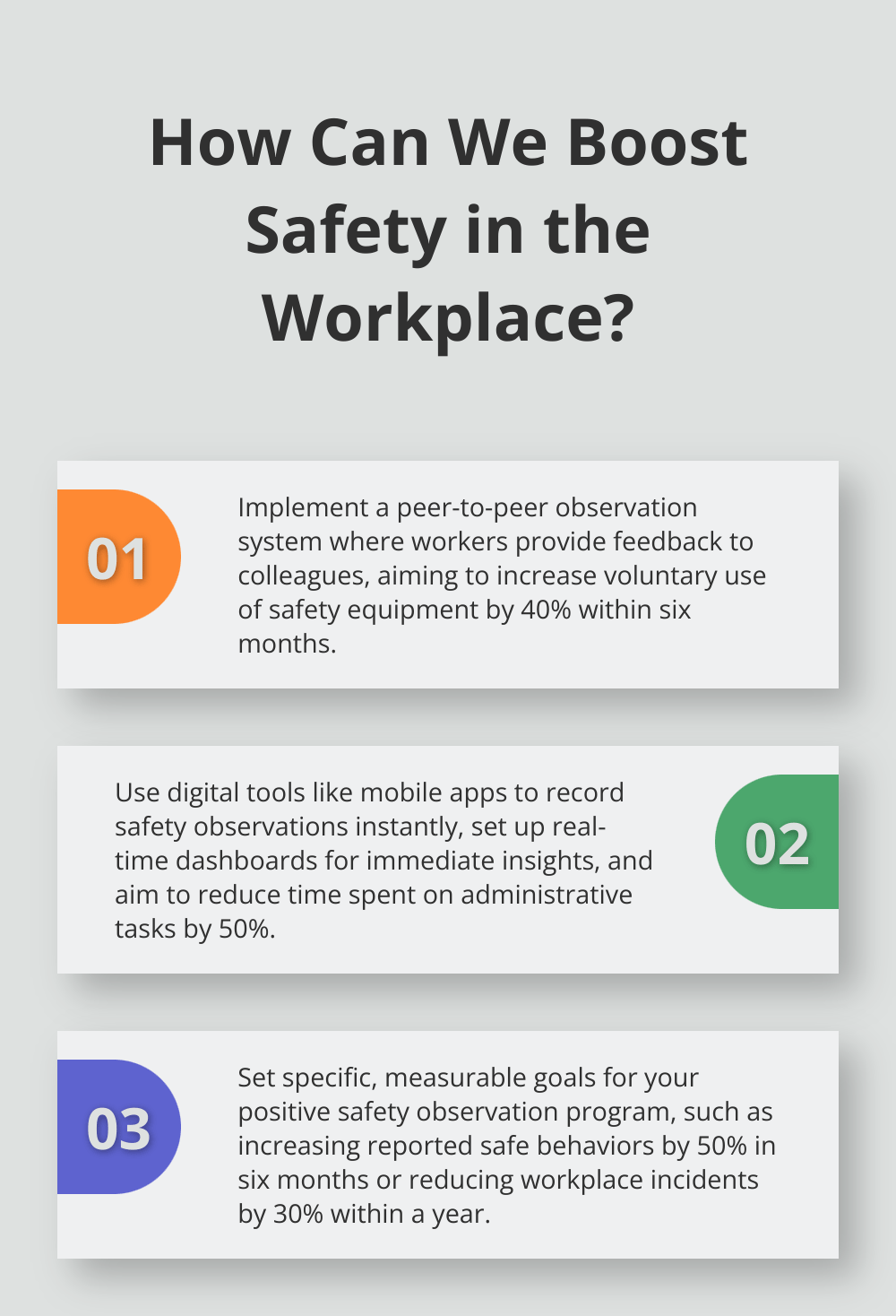The Power of Positive Safety Observations
At Weever Apps, we’ve seen firsthand how positive safety observations can transform workplace safety culture. This approach shifts focus from punitive measures to recognizing and reinforcing good safety practices.
Positive safety observations not only boost employee morale but also lead to fewer accidents and injuries. In this post, we’ll explore how to implement this powerful tool and reap its benefits for your organization.
What Are Positive Safety Observations?
Defining Positive Safety Observations
Positive safety observations represent a proactive approach to workplace safety. This method focuses on recognizing and reinforcing safe behaviors rather than solely identifying hazards or violations. The approach transforms safety cultures across various industries by shifting the focus from punitive measures to celebrating good safety practices.
The Impact of Positive Reinforcement
When employees receive acknowledgment for following safety protocols, they tend to repeat those behaviors. A study from the National Safety Council revealed that organizations investing in comprehensive safety training can reduce incident rates significantly. This demonstrates the effectiveness of moving from a punitive approach to one that celebrates safety compliance.
Positive vs. Negative Observations
Traditional safety observations often emphasize identifying and correcting unsafe acts. While this approach has its place, it can create a culture of fear and reluctance to report issues. Positive safety observations, in contrast, create a supportive environment where employees feel valued for their contributions to safety.

Consider this example: Instead of only noting when an employee fails to wear proper Personal Protective Equipment (PPE), a positive observation recognizes those who consistently use their safety equipment correctly.
Tangible Benefits of Positive Observations
The implementation of a positive safety observation program yields numerous advantages:
-
Increased Employee Engagement: Workers who receive regular positive feedback are more likely to engage at work. This engagement translates to better overall performance and safety awareness.
-
Improved Safety Culture: Companies with strong safety cultures experience fewer safety incidents. Consistent recognition of safe behaviors helps ingrain safety into daily operations.
-
Enhanced Communication: Positive observations open channels for constructive dialogue about safety practices. This improved communication can lead to an increase in overall safety compliance.
-
Data-Driven Improvements: The documentation of positive behaviors allows organizations to identify best practices and areas for improvement. This data-driven approach enables targeted training and resource allocation.
Tools for Effective Implementation
To maximize these benefits, organizations need tools that streamline the observation process. Digital platforms (such as Weever Apps’ Connected Worker platform) offer intuitive forms for easy data capture and real-time dashboards for cross-team visibility. These features make it simple to implement and maintain a positive safety observation program.
The next step in leveraging positive safety observations involves creating a structured program within your organization. Let’s explore how to set up an effective system that encourages participation and drives meaningful results.
How to Build an Effective Positive Safety Observation Program
Establish Clear Objectives
Define specific, measurable goals for your positive safety observation program. These might include increasing the number of reported safe behaviors by 50% in six months or achieving a 30% reduction in workplace incidents within a year. Clear objectives provide direction and allow you to track progress effectively.
Develop a Structured Observation Process
Create a standardized process for conducting observations. This should include straightforward instructions and cover all necessary steps, from beginning to end. Consider incorporating checklists and visual aids like screenshots to make the process clear and easy to follow.
Train Observers Effectively
Proper training ensures the success of your program. Observers need to understand not just what to look for, but how to approach employees positively. Role-playing exercises can be particularly effective. Practice scenarios where observers provide constructive feedback on safe behaviors they’ve witnessed. This helps build confidence and ensures consistency in the observation process.
Leverage Technology for Efficiency
Digital tools can significantly streamline the observation process. Mobile apps allow observers to record findings instantly, eliminating paperwork and reducing the time spent on administrative tasks. Real-time dashboards provide immediate insights, enabling quick action on trends or issues. For instance, Weever Apps’ Connected Worker platform offers intuitive digital forms for easy data capture and real-time analytics, making it simpler to implement and maintain a positive safety observation program.
Encourage Employee Participation
Make the program inclusive by involving employees at all levels. Consider implementing a peer-to-peer observation system where workers observe and provide feedback to their colleagues. This approach can increase engagement and create a sense of shared responsibility for safety. A construction company that implemented this strategy saw a 40% increase in voluntary use of fall protection gear.

The next step in maximizing the impact of positive safety observations involves understanding how they shape workplace culture and drive tangible improvements in safety outcomes.
How Positive Safety Transforms Workplace Culture
From Blame to Improvement
Positive safety observations revolutionize workplace culture. Companies that prioritize this approach abandon the blame game. Instead of focusing on mistakes, employees and managers recognize and celebrate good practices. This shift creates an atmosphere where people discuss safety concerns without fear of repercussions.

A manufacturing plant implemented this approach and witnessed a 30% increase in voluntary safety reports within six months. Employees felt empowered to speak up about potential hazards, which led to proactive problem-solving.
Morale and Engagement Boost
Recognition for safe behaviors works wonders for employee morale. Workers who feel valued for their safety contributions stay more engaged and committed to their jobs. The American Society of Safety Professionals reports that companies with strong safety cultures experience 48% fewer safety incidents.
Numbers tell only part of the story. Positive safety observations create a sense of pride among workers. They begin to see themselves as safety champions, actively seeking ways to improve workplace conditions. This heightened engagement often spills over into other work areas, boosting overall productivity.
Accident Reduction Through Awareness
As positive safety observations become the norm, employees tune in to their surroundings. They notice potential hazards they might have overlooked before. This increased awareness naturally leads to fewer accidents and injuries.
A construction company adopted a positive safety observation program and saw a 40% decrease in reportable incidents over two years. Workers used proper equipment and followed safety protocols more consistently when they knew their efforts received recognition and appreciation.
Technology’s Role in Positive Safety
Digital tools play a vital role in implementing effective positive safety observation programs. Platforms like Weever Apps (our top choice in this field) offer intuitive digital forms for easy data capture and real-time dashboards for cross-team visibility. These features simplify the process of recording and analyzing positive safety behaviors, making it easier for organizations to maintain and improve their safety culture.
Long-Term Cultural Shift
The impact of positive safety observations extends beyond immediate safety improvements. It fosters a culture of continuous improvement and mutual respect. Employees start to view safety not as a set of rules to follow, but as an integral part of their job (and a source of pride).
This cultural shift often results in improved communication across all levels of the organization. As safety discussions become more open and positive, other workplace conversations follow suit. The result? A more collaborative, innovative, and productive work environment.
Final Thoughts
Positive safety observations transform workplace safety culture. Organizations that implement this approach create an environment where employees feel valued and engaged. This shift from punitive measures to recognizing good safety practices reduces accidents and injuries while boosting morale and productivity.

Companies that adopt positive safety observations experience fewer incidents, improved employee engagement, and enhanced communication. This approach fosters a culture of continuous improvement, integrating safety into every job. Consistent implementation through regular training, clear processes, and effective tools (such as Weever Apps’ Connected Worker solution) streamlines observation and reporting.
We urge companies to make positive safety observations a cornerstone of their safety strategy. This method improves workplace safety and contributes to a more collaborative, innovative, and productive environment. It empowers everyone to contribute to a safer workplace, leading to tangible improvements in safety outcomes and overall organizational performance.